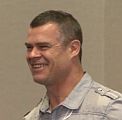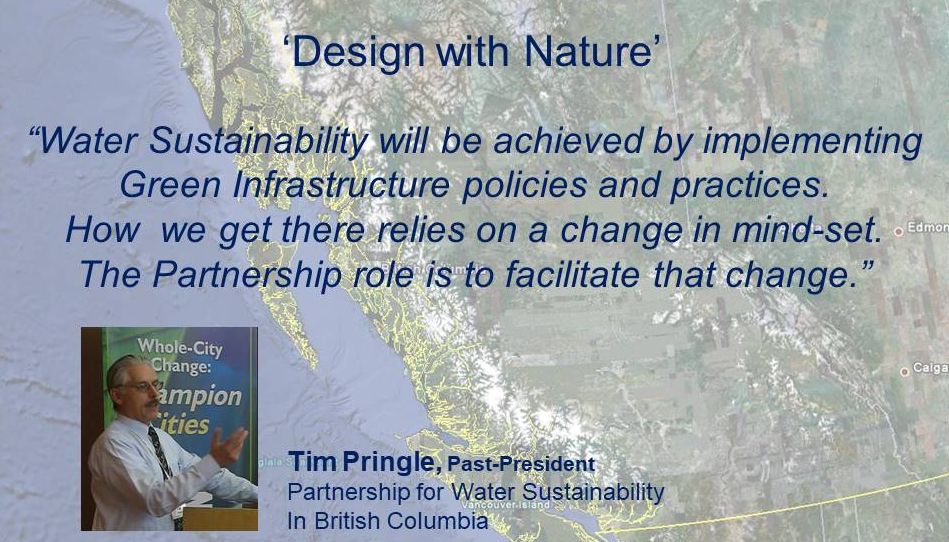Green Infrastructure Community-of-Practice is the online home for EAP, the Ecological Accounting Process, which is an initiative of the Partnership for Water Sustainability for British Columbia

“Commencing with a launch announcement by the BC Minister of Environment in 2005, this community-of-practice has served an important function as the home for green infrastructure in British Columbia. Originally created to support the work of the Green Infrastructure Partnership, the community-of-practice now has a dual focus in supporting two interconnected initiatives, that is: EAP, the Ecological Accounting Process: and Asset Management for Sustainable Service Delivery in BC, which is led by Asset Management BC,” stated Mike Tanner, Waterbucket Chair.
HOW WE CHANGE WHAT WE ARE DOING ON THE LANDSCAPE: Synthesis Report on EAP, the Ecological Accounting Process, a BC Strategy for Community Investment in Stream Systems (released by the Partnership for Water Sustainability, June 2022)

“In 2016, the Partnership embarked upon a 6-year program of applied research to evolve EAP through a 3-stage building blocks process of testing, refining, and mainstreaming the methodology and metrics for financial valuation of stream systems. The program involved 9 case studies and 13 local governments and yielded 19 “big ideas” or foundational concepts. The program goal was to answer the question, how much should communities budget each year for maintenance and management of stream systems,” stated Tim Pringle.
HISTORY OF GREEN INFRASTRUCTURE IN BRITISH COLUMBIA: “The Partnership for Water Sustainability is the keeper of the GIP legacy,” stated Paul Ham, a Past-Chair of the Green Infrastructure Partnership

During the period 2003 through 2010, the Green Infrastructure Partnership played a prominent role in leading change and assisting with implementation of the Water Sustainability Action Plan for British Columbia, primarily in the Metro Vancouver region. “I see my years of chairing the GIP as helping to get the ball rolling and ideas disseminated, on green infrastructure, all of which has subsequently been taken up by others to a much greater degree of implementation and success. Our efforts a decade ago moved the state of-the-art of green infrastructure to a more mainstream level,” said Paul Ham.
FLASHBACK TO 2007: What is “Green Infrastructure”? Looking back to understand the origin, meaning and use of the term in British Columbia

In 2007, the first Beyond the Guidebook guidance document provided a clear distinction between natural and engineered green infrastructure. “Two complementary strategies can ‘green’ a community and its infrastructure: first, preserving as much as possible of the natural green infrastructure; and secondly, promoting designs that soften the footprint of development,” wrote Susan Rutherford. “Green infrastructure design is engineering design that takes a ‘design with nature’ approach, to both mitigate the potential impacts of existing and future development and growth and to provide valuable services.”
DESIGN WITH NATURE TO CREATE LIVEABLE COMMUNITIES AND PROTECT STREAM HEALTH: “By 2010, we were beyond the innovation stage. The prevailing attitude was let’s get it done. We were action-oriented,” stated Ray Fung, a retired Director of Engineering in local government, and former Chair of the Green Infrastructure Partnership

“And then something happened. We just seemed to lose momentum in the 2010s. With the benefit of hindsight, others have made the same observation. We got bogged down in the implementation plan. We just talked about the burden on local governments from all the capital items that were arising from the completion of integrated stormwater management plans. Coincidentally, this was just as the region’s needs became dominated by transportation, transit, active transportation and cycling. And then we were hit by the pandemic in 2020 and this huge retirement wave,” stated Ray Fung.
REGIONAL GROWTH STRATEGIES FOR HEALTHY COMMUNITIES: “In the 2000s, we understood that we were going to have to do cities quite differently if we wanted to achieve the sustainability goals that we had set for ourselves. And that was going to require substantial degrees of innovation,” stated Dale Wall, former Deputy Minister of Municipal Affairs

“As a matter of policy, the Province was quite deliberate in the sense that we wanted to push the boundaries of how municipal infrastructure was developed. We knew that we were going to have to do this under pretty strict fiscal constraints. And so that is why innovation became so important. We used the slogan The New Business As Usual to convey the message that, for change to really occur, practices that until then had been viewed as the exception must become the norm moving forward. With the new grant programs, we had some funding to support innovation,” stated Dale Wall.
DESIGN WITH NATURE TO CREATE LIVEABLE COMMUNITIES AND PROTECT STREAM HEALTH: “There are initiatives and programs flourishing today that had their beginnings in the Georgia Basin Initiative,” stated Joan Sawicki, land and resource management champion, and former provincial cabinet minister

“And isn’t that how turning that supertanker of thinking happens? Just incrementally, then by gosh, we end up going in a whole different direction than we were when we started,” stated Joan Sawicki, Parliamentary Secretary for the Georgia Basin Initiative. Launched in 1994, the GBI was a call to action by the provincial government led by Premier Mike Harcourt. The living legacy of the GBI is embedded in and embodied by the Georgia Basin Inter-Regional Educational Initiative. The IREI is now in Year 13 and provides peer-based education among local governments.
DESIGN WITH NATURE TO CREATE LIVEABLE COMMUNITIES AND PROTECT STREAM HEALTH: “In the mid-1990s, I embarked on applied research that has defined my career with the District of North Vancouver. UBC’s Hans Schreier inspired me,” stated Richard Boase, career environmental champion within local government in the Metro Vancouver region

“When I look back at our history, I think wow, how did we do so much applied research. We had a need and Hans Schreier had grad students who were interested in doing the research. Win-win,” stated Richard Boase. “This research was in pursuit of making changes to the fabric of our urbanized areas. I was so encapsulated by what I saw around me, and the need for change, that my mind was always racing. And I needed to find ways to do research into what we were talking about.”
EAP, THE ECOLOGICAL ACCOUNTING PROCESS, IS A FINANCIAL TOOL TO HELP STREAMS SURVIVE: “We are in a 3-year transition strategy to embed EAP at Vancouver Island University. We can see the many directions EAP could take,” stated Anna Lawrence, Project Coordinator, Mount Arrowsmith Biosphere Region Research Institute at VIU

“There are so many different parts to EAP. And with each part you can go down a distinct pathway that helps local governments. I am very focused on the 3-year transition strategy because Year One was just trying to absorb as much knowledge as possible. It was a juggling process with many moving parts and trying to keep them all in balance. But Year One is now behind us. We are envisioning other areas of research as potential EAP projects.. And so, we look forward to sharing our EAP experience at the BC Land Summit,” stated Anna Lawrence.
DELTA’S RAIN GARDEN PROGRAM FOR STREETSCAPE REVITALIZATION: “The road designers are taking the initiative to incorporate linear rain gardens,” stated Harvy Singh Takhar, Utilities Engineer with the City of Delta in Metro Vancouver

“By working with the roads people on curb cuts, we have actually come up with variations. Our original detail was quite generic. Now we are able to implement it in various types of curb designs. We are striving to make sure that rain garden maintenance is as easy as possible, including inlets and outlets for drainage. We have evolved the designs so it is EASY CLEAN for all the sediment buildup. Our crews can quickly scoop it with a shovel and be on their way! That change resulted from feedback from engineering operations staff regarding what they wanted to see. We just evolved the design as per their operational needs,” stated Harvy Takhar.
DESIGN WITH NATURE TO CREATE LIVEABLE COMMUNITIES AND PROTECT STREAM HEALTH: “Broaden our standards so that we have the plethora of solutions on the table. It starts with education, at both the institutional and government levels, to understand why green infrastructure is necessary. And then, apply those broader solutions,” stated Hugh Fraser, former Deputy Director of Engineering, City of Delta

“Drainage is but a sub-set of municipal engineering. Historical engineering practice did not consider some of the broader objectives that we now try to address through green infrastructure. Drainage in the context of urban planning and development decisions has historically been an afterthought,” stated Hugh Fraser. “Delta urban areas are built out. The municipality is effectively limited to retrofitting of rain gardens within road corridors in order to provide rainwater infiltration that protects stream health. Road rights-of-way account for one-third of the land area of a typical urban watershed.”
DESIGN WITH NATURE TO CREATE LIVEABLE COMMUNITIES AND PROTECT STREAM HEALTH: “There was tension between stakeholders. Yet the productiveness of those dialogues inspired a lot of professionals, myself included, to dig deeper and find solutions and learn. You felt like you were part of a movement,” recalled Susan Haid, career environmental and urban planner in BC local government

Susan Haid has played a leadership role in trailblazing an ecosystem-based approach to community planning in British Columbia. “The 1990s was a very instrumental time of policy and regulation development. And municipal dialogue too. The discussions around the Fish Protection Act had a huge influence shifting perspectives to a bigger scale. The course that I teach at UBC is about how policy frameworks shape urban design. Building in resiliency to our cities from the site level to the regional level could NOT be more critical than now,” stated Susan Haid.
REFLECTIONS ON CREATING A CULTURE OF APPRECIATION IN THE CITY OF COQUITLAM: “Balance. Alignment. Appreciation. Three words that capture so much. They are foundation pieces for creating a culture of collaboration which is a steppingstone to a culture of appreciation,” stated Pete Steblin, former City Engineer and City Manager

“Good decision-making comes down to a good process. But it also relies on wisdom in terms of balanced advice. The essence of my guiding philosophy as a City Manager is distilled into the three Ts which are trust, time and think. Staff gives good advice and Council makes the decisions,” stated Pete Steblin. “When there is a significant level of trust in technical recommendations, Councils rarely override them. Staff explains recommendations. The Council makes the decisions. Trust is fragile and can easily be broken. When trust is lost, decades of good work can be lost.”
EAP, THE ECOLOGICAL ACCOUNTING PROCESS, IS AN EXPRESSION OF BLUE ECOLOGY: “Both are all about a restorative framework and mindset. This means restoring the interconnectivity and function of natural systems in a way that truly represents their importance,” stated Richard Boase, career environmental champion within local government

“We must do a better job of protecting streams. I am in a position now to reflect on this because I believe I have earned that right over the course of a 30-year career. Given how much I have seen, done and been exposed to in my local government career, it is fair for me to reflect on what has happened and comment on why local governments have not been as successful as we would have wanted. But we must focus on the path forward so that we protect or enhance stream systems in the built environment,” stated Richard Boase.


